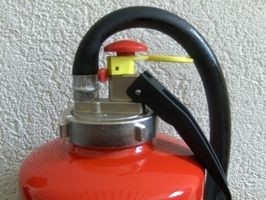Workplace Health & Safety For Fires

Listening to a talk on fire safety or participating in a fire drill might seem boring, and a reason for paying attention might only be appreciated in hindsight. Once ignited, a fire can spread very rapidly, not leaving much time for escape. History shows us the pain, loss and horror that neglect of workplace fire safety has generated. For this reason, laws are in place that are designed to prevent the pain and suffering caused by fire.
Fire Prevention
According to an article in the New York Times -- "141 Men and Girls Die in Factory Fire"-- published the day after the fire, a flash of flames was seen in a corner where some were working. The flames spread very rapidly, and in a half hour the fire had spread throughout the building.
Today, OSHA standards require written and oral fire prevention plans to be available in the workplace for employee reference. These plans should include a list of all of the main fire hazards on the premises, plus maintenance procedures and equipment required for control of these hazards. In addition, names or job titles of people responsible for prevention and control of fire risks must be made available to employees.
Fire Exits
Adequate fire escapes are required by law.
According to The New York Times article, Fire Chief Coker of the NYC Fire Department said "I have been advocating and agitating that more fire escapes be put on factory buildings similar to this. The large loss of life is due to this neglect." Now, according to OSHA, a workplace is required to have at least two exit routes in order for prompt evacuation to occur during an emergency--more if necessary to evacuate all employees safely.
Expert Insight
A good resource for fire safety information is the National Fire Protection Association (NFPA). A nonprofit organization formed in 1896, it is dedicated to reducing the effects of fire on the quality of life worldwide.
Fire Prevention
According to an article in the New York Times -- "141 Men and Girls Die in Factory Fire"-- published the day after the fire, a flash of flames was seen in a corner where some were working. The flames spread very rapidly, and in a half hour the fire had spread throughout the building.
Today, OSHA standards require written and oral fire prevention plans to be available in the workplace for employee reference. These plans should include a list of all of the main fire hazards on the premises, plus maintenance procedures and equipment required for control of these hazards. In addition, names or job titles of people responsible for prevention and control of fire risks must be made available to employees.
Fire Exits
Adequate fire escapes are required by law.
According to The New York Times article, Fire Chief Coker of the NYC Fire Department said "I have been advocating and agitating that more fire escapes be put on factory buildings similar to this. The large loss of life is due to this neglect." Now, according to OSHA, a workplace is required to have at least two exit routes in order for prompt evacuation to occur during an emergency--more if necessary to evacuate all employees safely.
Expert Insight
A good resource for fire safety information is the National Fire Protection Association (NFPA). A nonprofit organization formed in 1896, it is dedicated to reducing the effects of fire on the quality of life worldwide.
- 0h3dc41707289b1bafbe7c0b38457b9f4e.jpg